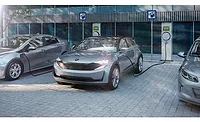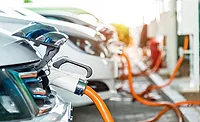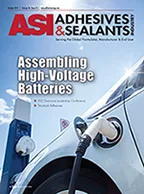Advancing Adhesives
Sealing Solution for Electric Vehicles
Structural adhesives for battery pack assemblies in electric vehicles help ensure long-life components operation.

Fig. 1. Placement of an electric battery in the vehicle.

Fig. 2. Several layers/components are used in an electric vehicle battery.
Developers of electric vehicles are on a very steep learning curve. Advancements seem to be emerging almost daily—especially as they relate to the power source, which includes battery pack design, engineering and assembly.
In recent years, several factors have accelerated the growth of the emerging electric and hybrid cars market. Strict government regulations are obliging vehicle manufacturers to be involved in the electrification of their fleet. At the same time, financial incentives from governments are enticing consumers to buy electric or hybrid vehicles.
Battery packs for electric vehicles face many of the same challenges that the vehicles themselves must overcome—safety, reliability, durability and consumer confidence. Adhesives are already onboard to address these issues, and more.
Electric Vehicle Battery Packs
The so-called skateboard-type battery packs sit under the floor of the passenger cabin between the front and rear wheels and can weigh up to 700 kg or more. The battery pack accommodates a number of modules, each housing multiple pouch, prismatic or cylindrical cells. These modules are typically contained in aluminum or composite enclosures, which are secured within a frame that has a protective top and bottom and an internal crash reinforcing frame tray.
Often, the vehicle manufacturer designs the entire battery—complete with the control unit—so that it can be removed from the vehicle, if needed, and individual modules removed or replaced. Durability is important because the batteries should last as long as the vehicle, which can be up to 15 years.
Battery temperature is exceptionally important for performance and should stay optimal at 25°C and should never exceed 60°C at all times—especially during operation and charging. Aluminum channels are bonded to the bottom of the battery tray to provide heating or cooling as needed. To maintain a consistent temperature across the modules, a thermal interface material (TIM) is often used between the modules and the cooling plate.
This thermal management system is also important to the overall safety performance of the battery system. The goal is to avoid hotspots, where battery cells operate at a higher temperature than the other cells. This could initiate thermal runaway, leading to a potentially catastrophic outcome.
Another key consideration in the overall performance of electric vehicles is efficiency and gaining as many drivable miles without recharge as possible. Obviously, lightweighting is important here and is often managed by using a variety of substrates.
The Benefits of Adhesives
It’s easy to see many opportunities for adhesives to add value to this emerging technology. In fact, adhesives are already being used for thermal management and conductivity; inhibition of noise, vibration and harshness; corrosion protection; and improved manufacturing efficiencies via robotic application.
Dow Automotive adhesives are used on battery packs across the emerging range of electrified powertrain designs for mild hybrid, full hybrid, plug-in hybrid and full electrical vehicles set to launch prior to 2025. The adhesives also are part of the AHEAD™ initiative, which provides a larger portfolio of products targeted at accelerating electrification for vehicles globally.
Epoxy adhesives are used to help improve crashworthiness and integrity of the battery pack. Polyurethane adhesives are being specified for application areas where they will inhibit vibration and enable bonding of multiple substrates at cold cure temperatures.
Multi-material bonding solutions also enable the use of dissimilar materials and help achieve lightweighting goals, which help compensate for the battery mass. Lightweight multi-material battery packs and battery frames benefit from these adhesives, which also help manage differences in thermal expansion. An additional advantage is that these solutions support a range of robotic as well as manual application methods, including bead, injection and gap-filling.
Epoxy-based toughened structural bonding solutions are ideal for bonding uncoated metal and offering compatibility with glycol and similar materials for inner pack assemblies. The main reason adhesive is chosen is to bond multiple substrates and achieve crash durability over the lifetime of the battery. Structural adhesives improve the integrity of the battery pack assembly in the body-in-white stage. Rapid-cure options that enable short cycle times are also required. Typical application areas include the battery case and frame bonding.
Polyurethane-based elastic structural bonding solutions can be used when an application requires vibration inhibitions, gap variations and tensions caused by thermal differences between substrates. These adhesives can enable the assembly of light and economical substrates while keeping process steps and VOCs to a minimum. Typical applications include bonding battery cells into a battery module tray, frames and cooling units. Typical substrates include composites, thermoplastics, coated steel, and coated or uncoated aluminum.
Thermal-conductive adhesives bond well to coated and uncoated aluminum. In addition to providing thermal management capabilities, the adhesive can also act as a vibration inhibitor. A typical application involves the bonding of an e-coated aluminum heating/cooling unit assembly into a battery pack.
Thermal-conductive gap fillers are compatible with bare aluminum and offer the in-cycle time dispensing and pressure management that are needed to assemble the modules. They also provide excellent flowability (wetting) and demountability to accommodate repairs.
Sealers can also adhere to uncoated aluminum and could be used for protection plate bonding, sealing of spot-welds and sealing the battery upper cover, as well as enabling repairs, while sealing against external environmental debris such as salt, oil, dirt and water.
Electric Vehicle Forecast
The manufacture and sale of electric vehicles is expected to grow significantly. Some say that by 2040, electric vehicles will make up 54% of new car sales, or represent 33% of the global car fleet.1
When considering the value chain for the electrification process, there are several new players—battery manufacturers and suppliers of electronic components, body components, powertrain components, and battery pack assembly solutions. All of these suppliers must work together to achieve the best results possible as this technology moves forward.
Adhesives are enjoying success milestones across seven different areas: safety, performance, lifecycle, profitability, sustainability, driver experience and aftermarket serviceability. All of these areas are under consideration as we proceed with product development and the introduction of materials into this fast-growing market. ASI
For more information, visit www.dowautomotive.com.
Reference
1. Bloomberg NEF, https://about.bnef.com/blog/electric-vehicles-accelerate-54-new-car-sales-2040
Looking for a reprint of this article?
From high-res PDFs to custom plaques, order your copy today!







